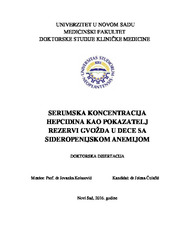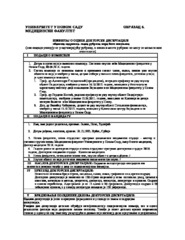Serumska koncentracija hepcidina kao pokazatelj rezervi gvožđa u dece sa sideropenijskom anemijom
Serum concentration of hepcidin as an indicator of iron reserves in children with iron deficiency anemia
| dc.contributor.advisor | Kolarović, Jovanka | |
| dc.contributor.other | Konstantinidis, Nada | |
| dc.contributor.other | Kostić, Gordana | |
| dc.contributor.other | Čabarkapa, Velibor | |
| dc.contributor.other | Stojadinović, Aleksandra | |
| dc.contributor.other | Katanić, Jasmina | |
| dc.creator | Ćulafić, Jelena | |
| dc.date.accessioned | 2016-12-09T16:38:56Z | |
| dc.date.available | 2016-12-09T16:38:56Z | |
| dc.date.available | 2020-07-03T13:26:37Z | |
| dc.date.issued | 2016-10-24 | |
| dc.identifier.uri | https://nardus.mpn.gov.rs/handle/123456789/7132 | |
| dc.identifier.uri | http://www.cris.uns.ac.rs/DownloadFileServlet/Disertacija14696949314830.pdf?controlNumber=(BISIS)101619&fileName=14696949314830.pdf&id=6623&source=NaRDuS&language=sr | sr |
| dc.identifier.uri | http://www.cris.uns.ac.rs/record.jsf?recordId=101619&source=NaRDuS&language=sr | sr |
| dc.identifier.uri | http://www.cris.uns.ac.rs/DownloadFileServlet/IzvestajKomisije146969494535017.pdf?controlNumber=(BISIS)101619&fileName=146969494535017.pdf&id=6624&source=NaRDuS&language=sr | sr |
| dc.identifier.uri | null/DownloadFileServlet/IzvestajKomisije146969494535017.pdf?controlNumber=(BISIS)101619&fileName=146969494535017.pdf&id=6624 | |
| dc.description.abstract | Anemija predstavlja problem svetskih razmera sa značajnim zdravstvenim, socijalnim i ekonomskim konsekvencama. Iako je pre mnogo godina prepoznata kao javnozdravstveni problem, malo je učinjeno u uspostavljanju kontrole anemije i prevalenca je ostala neprihvatljivo visoka. Deficit gvožđa predstavlja najčešći uzrok anemije, deca uzrasta od 6-24 meseca i adolescenti predstavljaju vulnerabilne grupe. Hepcidin je peptidni hormon niske molekularne težine koji ima ključnu ulogu u metabolizmu gvožđa. Cilj istraživanja je bio da se odredi serumska koncentracija hepcidina kod dece uzrasta od 6 meseci do 2 godine i adolescenata uzrasta od 11 do 19 godina koji boluju od sideropenijske anemije i uporedi sa serumskim koncentracijama hepcidina u kontrolnim grupama, kao i da se utvrdi njegova povezanost sa parametrima metabolizma gvožđa. Ispitivanjem je obuhvaćeno ukupno 173 ispitanika, 89 ispitanika koji su bolovali od sideropenijske anemije i 84 ispitanika koji nisu bolovali od sideropenijske anemije i koji su predstavljali kontrolnu grupu. Svim ispitanicima je venepunkcijom uzorkovana krv za određivanje kompletne krvne slike i prametara metabolizma gvožđa. ELISA metodom je određen nivo hepcidina u serumu. Ispitivanjem je utvrđeno da je koncentracija hepcidina statistički značajno niža u dece i adolescenata koji boluju od sideropenijske anemije u poređenju sa decom i adolescentima koji ne boluju od sideropenijske anemije. Potvrđena je pozitivna korelacija između koncentarcije serumskog hepcidina i gvožđa u serumu, feritina, srednjeg volumena eritrocita i saturacije transferina, a negativna korelacija između koncentracije serumskog hepcidina i transferina i broja retikulocita. Koncentracija transferina i nezasićeni kapacitet vezivanja gvožđa, ukupni kapacitet za vezivanje gvožđa i broj retikulocita su međusobno u pozitivnoj korelaciji, a korelacija koncentracije transferina sa parametrima saturacija transferina, koncentracije gvožđa i hemoglobina je negativna. Na vrednost serumskog hepcidina ne utiču niti pol niti uzrast ispitanika što ga čini senzitivnijim pokazateljem stanja gvožđa u organizmu i pouzdanijim biološkim markerom u dijagnostici sideropenijske anemije. | sr |
| dc.description.abstract | Anemia represents a worldwide problem which leads to substantial health, social and economic issues. Although it was identified as a common health problem many years ago, not a lot has been done in controlling anemia and its prevalence has stayed unacceptably high. The iron deficit is the most frequent cause of anemia, 6-24 month-old children and adolescents are vulnerable groups. Hepcidin is a peptide hormone of a low molecular weight which has a main role in the iron metabolism. The aim of the research was to determine the serum concentration of hepcidin in children aged from 6 months to 2 years and in adolescents from the age of 11 to 19 which suffer from iron deficiency anemia and compare it with the serum concentration of hepcidin in the control groups, as well as to determine its connection with the parameters of the iron metabolism. The research included 173 examinees, 89 of them suffered from iron deficiency anemia and 84 did not suffer from iron deficiency anemia. The latter represented the control group. All the examinees had their blood sampled intravenously in order for full blood count results and parameters of iron metabolism to be determined. Also, ELISA method was used for establishing the level of hepcidin in the serum. The research showed that the concentration of hepticin is statistically lower in children and adolescents who suffer from iron deficiency anemia in comparison with children and adolescents who do not have this condition. The positive correlation between the level of serum hepcidin and iron in the serum, ferritin, the medium volume of erythrocytes and transferrin saturation was confirmed but the negative one occurred in the level of the serum hepcidin, transferrin and reticulocyte. Transferrin and the unsaturated capacity of iron binding, the total capacity of iron binding and reticulocytes are in a positive correlation but the correlation of transferrin with the parameters of transferrin saturation, iron and hemoglobin is negative. The sex and the age of the examinees do not influence the level of serum hepcidin which makes it a more sensitive indicator of the level of iron in the body. Besides this, serum hepcidin is a reliable biological marker in the iron deficiency anemia diagnosis. | en |
| dc.language | sr (cyrillic script) | |
| dc.publisher | Универзитет у Новом Саду, Медицински факултет | sr |
| dc.rights | openAccess | en |
| dc.rights.uri | https://creativecommons.org/licenses/by-nc-nd/4.0/ | |
| dc.source | Универзитет у Новом Саду | sr |
| dc.subject | anemija | sr |
| dc.subject | Anemia | en |
| dc.subject | Iron Deficiency | en |
| dc.subject | Diagnosis | en |
| dc.subject | Iron | en |
| dc.subject | Infant | en |
| dc.subject | Adolescent | en |
| dc.subject | Biomarkers | en |
| dc.subject | Hepcidins | en |
| dc.subject | Anemia | en |
| dc.subject | hepcidini | sr |
| dc.subject | anemija usled nedostatka gvožđa | sr |
| dc.subject | dijagnoza | sr |
| dc.subject | gvožđe | sr |
| dc.subject | odojče | sr |
| dc.subject | adolescenti | sr |
| dc.subject | biomarkeri | sr |
| dc.title | Serumska koncentracija hepcidina kao pokazatelj rezervi gvožđa u dece sa sideropenijskom anemijom | sr |
| dc.title.alternative | Serum concentration of hepcidin as an indicator of iron reserves in children with iron deficiency anemia | en |
| dc.type | doctoralThesis | en |
| dc.rights.license | BY-NC-ND | |
| dcterms.abstract | Коларовић, Јованка; Чабаркапа, Велибор; Катанић, Јасмина; Стојадиновић, Aлександра; Константинидис, Нада; Костић, Гордана; Ћулафић, Јелена; Серумска концентрација хепцидина као показатељ резерви гвожђа у деце са сидеропенијском анемијом; Серумска концентрација хепцидина као показатељ резерви гвожђа у деце са сидеропенијском анемијом; | |
| dc.identifier.fulltext | https://nardus.mpn.gov.rs/bitstream/id/34820/Disertacija6692.pdf | |
| dc.identifier.fulltext | https://nardus.mpn.gov.rs/bitstream/id/34821/IzvestajKomisije6692.pdf | |
| dc.identifier.fulltext | http://nardus.mpn.gov.rs/bitstream/id/34820/Disertacija6692.pdf | |
| dc.identifier.fulltext | http://nardus.mpn.gov.rs/bitstream/id/34821/IzvestajKomisije6692.pdf | |
| dc.identifier.rcub | https://hdl.handle.net/21.15107/rcub_nardus_7132 |



